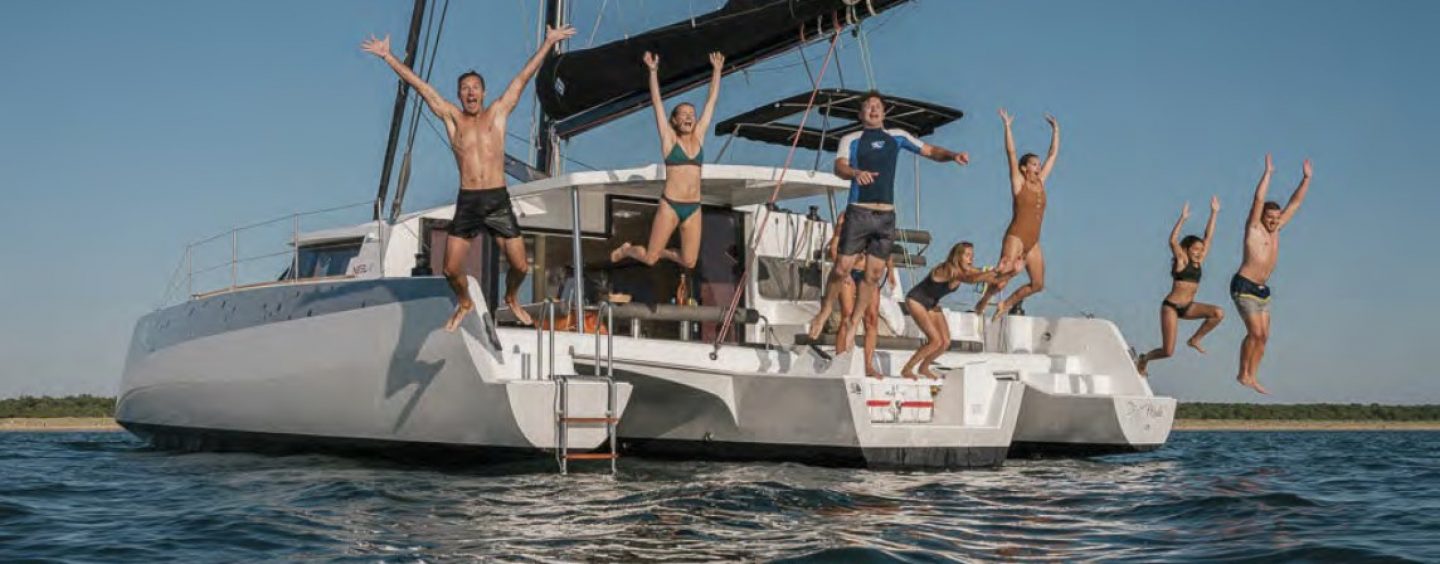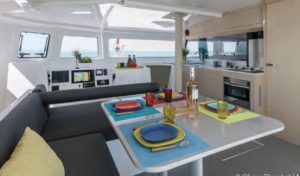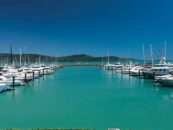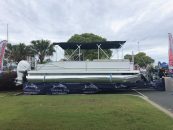HIGHLIGHTS BY KEVIN GREEN – READ THE FULL REPORT AT MULTIHULLSOLUTIONS.COM.AU
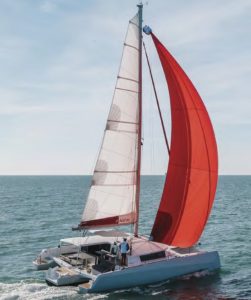 The Neel 43 is the latest evolution of this French builder’s trimaran range and the first of the brand to reach our shores, so two good reasons to go for a sail.
The Neel 43 is the latest evolution of this French builder’s trimaran range and the first of the brand to reach our shores, so two good reasons to go for a sail.
Trimarans rule the oceans when it comes to offshore speed records but in the cruising world they are much less distinguished. In the past, often epitomised by older more eccentric designs that perhaps required the more eccentric sailor. This image is one that Eric Bruneel has been steadily changing in the yard he established in 2010. The La Rochelle yard builds the Neel 47, 51, 65 and now the new 43. Eric says, ”When we start looking at smaller yachts the amount of gear that some cruising people wish to have aboard becomes a bigger issue relative to total displacement. As with any multihull, weight aboard is a critical part of the equation but we believe we have found a good ability to carry this weight and still have our owners enjoy great performance. ”
As of March 2022, hull number eight has been imported by Australian dealer Multihull Solutions and its Neel specialist Andrew De Bruin.
CONSIDER A TRIMARAN – The centralised weight of the Neel 43 allows it to operate in wider wind ranges than similar catamarans, as the trimarans typically can heel to about 10-20°, however the Neel 43 heels about 8° and with 25ft beam the stability is immense. You can expect cruising speeds of around 10kts, allowing impressive 200nm days, of course these figures will vary substantially with adverse swells.
Knowing what you want helps when going shopping, so choosing the Neel 43 is for those seeking performance cruising with a meaningful helming experience. Neel are very aware of weight efficiencies, and this is reflected in the modest 9,000 kg displacement of the Neel 43 – which is several tons lighter than its catamaran competitors. Simply put, Bruneel liked crossing oceans but didn’t want to spend too much time actually doing it.
INTERNAL SPACE – Stepping aboard via the wide ama steps then into the cockpit reveals a wide, open-plan approach that Marc Lombard has created for the 43. There is a spacious L-shaped dining area and a double bench facing aft. Integrating with the saloon, this space that Bruneel dubs the ‘Cockloon’ is fully shaded by a hardtop bimini and can seat 10 guests around the inside-outside tables.
For the saloon, sturdy double sliding doors seal it off and deep scuppers shed any water. There’s also a transom based wet bar and grill, so ideal for keeping the fumes out of the boat. For the dinghy, a clever idea of using the boom with topping lift and electric winch as a davit sets the dinghy safely across the hull. Adjoining the cockpit, with three steps up, is the single helm station on starboard; which can also be accessed from the deck.
The saloon has three double berths and a longitudinal galley with the bathroom/shower beside the outside doors – so ideally placed for cockpit guests. What this layout creates is a really liveable saloon space, with L-shaped dinette handily placed opposite the galley. Also functional is the navigation station in the forward port quarter, allowing steering by autopilot, should you choose to. Good natural light comes from tall windows all round and a small opening skylight.
FLEXIBLE SAILPLAN – The Neel 43 has an extensive sail plan, so ideal for the varied conditions often found while bluewater voyaging. Our review boat came with the upgraded taller carbon spars and Dyform wire shrouds, enhancing light air performance and reducing weight aloft.
This also allowed three reefs in the fully battened Incidences Dacron mainsail. A large foretriangle allows for a large genoa and there’s good separation on the fibreglass bowsprit for the asymmetric, that is deployed via a sock.
The single starboard helm station allows vision across the hulls and is protected by a canvas bimini. Behind the large steering wheel (800mm) is a stainless framed double seat that gives support and handholds. The console controls included a Maxpower bow thruster and B&G electronics with autopilot near at hand and throttle outboard for the 50hp saildrive engine – which has a folding propeller. The second one is electric for halyard hoists. A simple thimble arrangement runs the genoa sheets. Overhead, a canvas bimini shields you but can be unzipped to view the mainsail via clear plastic. The mainsail is controlled by twin sheets running on transom mounted blocks to give good leverage on the boom and is easily accessible from the flybridge sunpad; plus there’s lazyjacks to gather the sailcloth.
www.multihullsolutions.com.au
Published in print October-December 2022






















